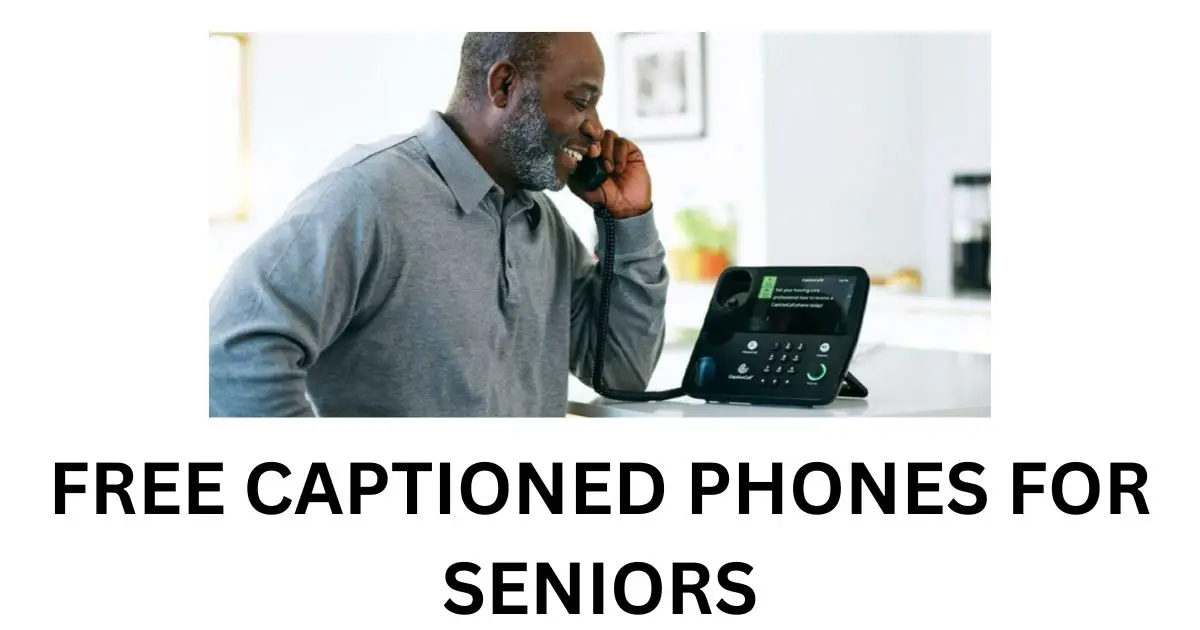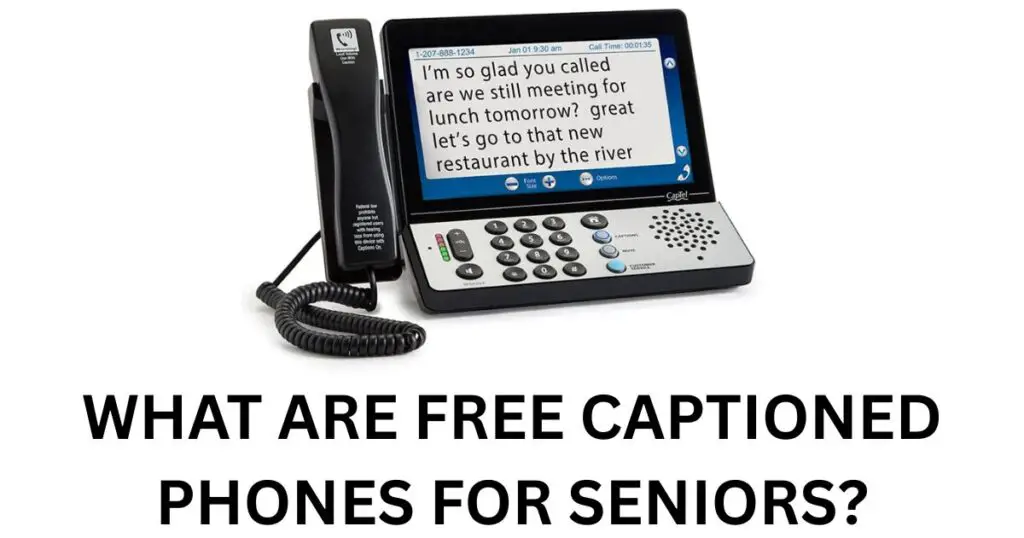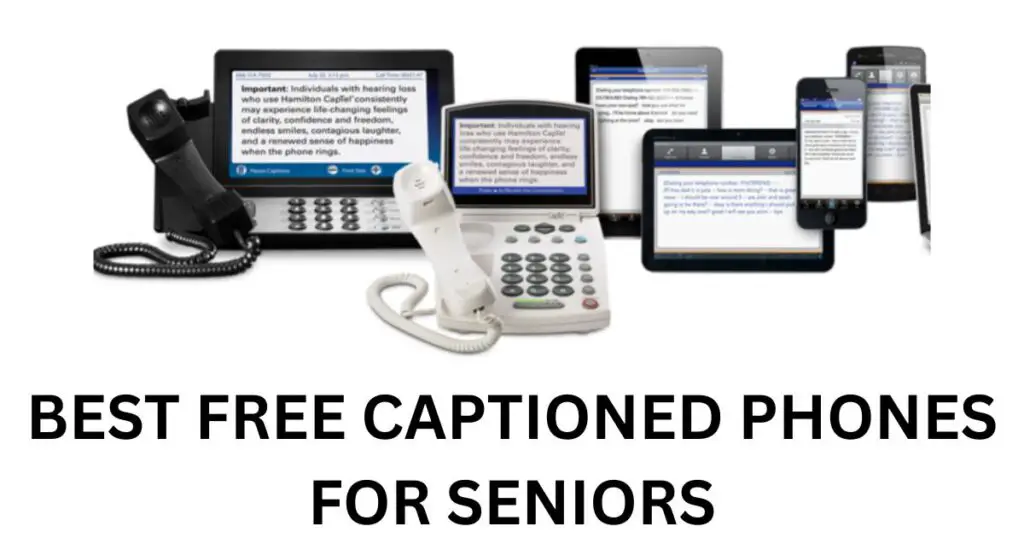Free Captioned Phones for Seniors: How to Get, Top Models

The news of my new appointment in another city was a mix of feelings for me. I was worried about how to keep in-touch with my grandmother who was with hearing loss.
Thankfully, my friend told me that I could get a captioned phone for her free of charge. I decided to try it out, and guess what? It was true and seamless.
In this post, I share how you can also get Free Captioned Phones for Seniors without a glitch.
What are Free Captioned Phones for Seniors?

Free Captioned Phones for Seniors are special telephones designed for seniors with hearing loss.
It works just like a regular phone but with one key difference — it displays real-time captions of the caller’s voice on a large screen, so the user can read what’s being said.
For a broader look at other communication options, check out our guide on Free Phones for Seniors to see what programs are available beyond captioned phones.
How to Get Free Captioned Phones for Seniors
Follow these steps to get Free Captioned Phones for Seniors:
- Confirm your eligibility
- Choose a free captioned phone provider
- Download the certification form from the provider’s website
- Have a licensed professional fill and sign the form to confirm you have hearing loss
- Submit the application form along with basic personal information
- Wait for approval
- Schedule delivery and installation
Eligibility Criteria for Free Captioned Phones for Seniors
These are the Eligibility Criteria for Free Captioned Phones for Seniors:
- Have hearing loss
- Live in the United State
- Read and speak English
- Have home internet access
Looking for more options beyond captioned phones? Our guide on Free Phones for Hard of Hearing Seniors can be helpful in exploring additional devices and support programs available.
Top 3 Programs Offering Free Captioned Phones for Seniors
These are the Top three Programs Offering Free Captioned Phones for Seniors:
1. FCC’s IP CTS Program (Internet Protocol Captioned Telephone Service)
The FCC’s IP CTS Program is funded by the Interstate Telecommunications Relay Services (TRS) Fund. This federal initiative partners with providers like CaptionCall, ClearCaptions, and Hamilton CapTel to deliver captioned phones at no cost. These providers also offer support services such as installation and training.
2. State Equipment Distribution Program (EDP)
The EDP is available in nearly every U.S. state. Each state runs its own version of the program to distribute telecommunications devices to residents with disabilities.
For instance, California operates the California Telephone Access Program (CTAP), Florida runs the Florida Telecommunications Relay, and Texas manages the Specialized Telecommunications Assistance Program (STAP).
These programs often include additional devices alongside captioned phones and may have varying application processes.
3. Veterans Affairs (VA) Program
This program supports eligible U.S. veterans with hearing loss. Through VA hospitals and audiology departments, veterans can receive captioned phones and other assistive technology as part of their medical benefits. This makes captioned communication more accessible to those who have served in the military.
Best Free Captioned Phones for Seniors

These are the Best Free Captioned Phones for Seniors:
1. CaptionCall 2400
The CaptionCall 2400 is a top-rated captioned phone with a large 7-inch touchscreen, amplified sound, and one-touch dialing.
It delivers near-instant captions and has a sleek, modern design. This model also includes Bluetooth support and voicemail captioning.
It’s ideal for seniors who are comfortable with smartphones or tablet along with clear captions with easy controls and volume boost.
2. ClearCaptions Ensemble
The ClearCaptions Ensemble is designed with accessibility in mind. It features an 8-inch high-contrast display and powerful speakers for extra-loud audio.
Its bold text and simple interface make it a great option for users with both hearing and vision difficulties.
It also includes built-in answering machine features and an easy-to-navigate menu.
3. Hamilton CapTel 2400i
This phone offers a large color touchscreen, captioned voicemail, and adjustable font sizes.
The Hamilton CapTel 2400i connects via internet and phone line, providing reliable real-time captions.
It’s a solid option for seniors who prefer landline use but want modern features.
4. CapTel 840i
CapTel 840i is designed for users who prefer traditional buttons over touchscreens.
It has a large backlit display, volume boost, and connects to the internet for real-time captioning.
It’s well-suited for seniors who like the feel of a standard phone but need caption support.
5. CapTel 880i
The CapTel 880i is built for seniors with both hearing and vision impairments.
It features extra-large text, amplified audio, and a simple navigation system.
Its high-contrast screen and large keypad make it extremely user-friendly for those with additional accessibility needs.
Comparison Table for the Best Free Captioned Phones for Seniors
This table compares the Best Free Captioned Phones for Seniors:
| Phone Model | Display Size | Type of Display | Amplified Sound | Captioning Speed | Keypad Type | Ideal For | Internet Required |
|---|---|---|---|---|---|---|---|
| CaptionCall 2400 | 7-inch | Touchscreen | Yes | Near-instant | Touchscreen | Seniors who prefer a modern look | Yes |
| ClearCaptions Ensemble | 8-inch | High-contrast | Yes | Fast | Touchscreen | Low vision + hearing loss | Yes |
| Hamilton CapTel 2400i | 7-inch | Color touchscreen | Yes | Fast | Touchscreen | Tech-savvy users with landlines | Yes |
| CapTel 840i | 5-inch | Backlit LCD | Yes | Fast | Physical buttons | Seniors preferring traditional phones | Yes |
| CapTel 880i | 5-inch (XL text) | High-contrast LCD | Yes (extra loud) | Fast | Physical buttons | Seniors with vision + hearing loss | Yes |
Top Three (3) Providers of Free Caption Phone for Seniors
These are the Top Three (3) Providers of Free Caption Phone for Seniors:
- CaptionCall: This is one of the most widely used models. It features a large touchscreen, clear audio, and fast, accurate captions. It also comes with free installation and training, making it an ideal choice for seniors who may need extra assistance setting it up.
- ClearCaptions: This is another top-rated option. It offers a bright, high-contrast screen, adjustable font sizes, and amplified sound, making it easier for users with both hearing and vision difficulties. ClearCaptions also provides home installation and personal instruction to help new users get started.
- Hamilton CapTel: This is known for offering both traditional landline and mobile captioning options. The phone displays captions in real time, and although it typically requires self-installation, it includes detailed instructions and online support for those who prefer to set it up independently. It’s a strong choice for seniors who are comfortable with technology and want flexibility in how they use their phone.
Do Free Captioned Phones for Seniors Require Internet?
Most free captioned phones require a high-speed internet connection to function properly. This is because the phones use the internet to display real-time captions during calls.
However, if the senior doesn’t currently have internet access, some providers can assist in finding affordable or discounted plans through federal programs like Lifeline or the Affordable Connectivity Program. This makes it possible for seniors to use caption phones even on a budget.
Access to affordable internet doesn’t have to be a barrier. Explore how Free Government Internet for Seniors can make it easier to use captioned phones at home.
Are Caption Phones free?
Caption phones are completely free for eligible users. There are no hidden fees, no monthly service charges, and no catch.
All that’s needed is a professional certification confirming hearing loss. This support ensures that communication remains open, no matter your age or hearing ability.
If you’re receiving Social Security benefits, you may also qualify for other communication programs. Learn more in our guide on Free Phones for Seniors on Social Security.
FAQs About Free Captioned Phones for Seniors
These are the Frequently Asked Questions About Free Captioned Phones for Seniors:
Can seniors get more than one device?
Each eligible individual is typically allowed only one free captioned phone per household or per user through FCC-certified programs.
Can I apply for Free captioned phones for seniors on behalf of a parent or grandparent?
You can absolutely apply on behalf of your parent or grandparent. You’ll need to provide their basic information and arrange for a certified professional—such as an audiologist, hearing instrument specialist, or doctor—to complete and sign the Professional Certification Form confirming the individual’s hearing loss.
Does a Senior need to reapply if he/she move to a different state?
Not necessarily. If you’re using a national provider like CaptionCall, ClearCaptions, or Hamilton CapTel, and your service remains the same, you may not need to reapply. However, you should update your address with the provider and check with them to confirm if any new documentation is required.
However, if you were using a state-run program, moving to a new state may require reapplying through that state’s equipment distribution program.
Is there a monthly fee for using the free captioned phones for seniors
or service?
There are no monthly fees. The captioning service is completely free and funded through the FCC’s TRS fund. You will not be billed for the phone or the captioning feature.
Can I keep my current phone number?
In most cases you can keep your current phone number. When setting up your new captioned phone, the provider can usually work with your existing number.
Conclusion
Free captioned phones for Seniors make a world of difference for seniors who struggle with hearing loss. Whether you’re a caregiver, veteran, or senior yourself, the process is easy — and the result is better connection, confidence, and clarity in every conversation.

